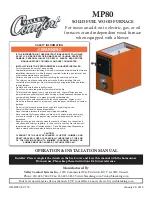
4
THERMOSTAT
This unit will not operate properly without a good quality,
correctly installed thermostat. It is very important that the
thermostat be located where it can best “sense” the average
room temperature.
Be sure that the thermostat is not exposed to hot or cold drafts or
to hot or cold spots on the wall, such as those received from
outside walls, walls with pipes inside, or from openings into the
attic.
No matter what type or style of thermostat is used, thermostat
operation is basically the same. The most widely used types will
control both heating and cooling functions and will have a fan
switch with AUTO and ON settings. On AUTO, the circulating air
blower will cycle on/off. When the switch is set to ON, the
circulating air blower will run constantly.
IMPORTANT NOTE: To avoid the possibility of damage to the
unit heat exchanger, do not set the fan switch to ON (constant fan
operation) during the heating season without first consulting the
installer of the unit or another qualified servicer.
There are thermostats that automatically switch from Heating to
Cooling, or with night setbacks. The night setback, or multiple
setback type, will lower the temperature at night or during the
day when the building is unoccupied.
Typical Thermostat
PROPANE (LP) GAS
INSTALLATIONS ONLY
For units operating on propane gas, please review the following
warnings before use.
OPERATING INSTRUCTIONS
Heating Start-Up
To put your unit into operation, follow the steps listed below.
1. Close the external manual gas shutoff valve.
2. Turn off the electrical power to the unit.
3. Set the room thermostat to the lowest possible setting.
4. Remove the heat exchanger door on the side of the unit by
removing the screws.
5. This unit is equipped with an ignition device which
automatically lights the burner.
NOTE: Do not try to light the burner by hand.
6. Move the gas control switch to the OFF position.
NOTE: Do not use excessive force.
7. Wait 5 minutes to clear out any gas. Then check for a gas
odor, including near the floor as some types of gas are
heavier than air.
8. If a gas odor is detected following the 5-minute waiting
period, immediately leave the building and call your gas
supplier or the fire department.
A. Cool/Heat temperature control dials
B. Fan switch
C. Cool/Heat switch
System
Switch
Fan
Switch
Action
OFF
AUTO
None
COOL
AUTO
System only cools; fan cycles off and on.
COOL
ON
System only cools; fan runs all the time.
HEAT
AUTO
System only heats; fan cycles off and on.
HEAT
ON
System only heats; fan runs all the time.
OFF
ON
No heating or cooling; fan runs all the time.
An undetected gas leak can create a danger of explosion
or fire. The unit and its gas connections must be leak
tested before placing in operation.
WARNING
A
B C
Goodman 85
To avoid property damage, personal injury or death due to
explosion or fire, install a gas detecting warning device.
Since the odorant in propane gas can be reduced by iron
oxide (rust), a gas detecting warning device is the only
reliable method to detect propane gas leaks.
WARNING
To avoid property damage, personal injury or death due
to fire, do not remove any internal compartment covers
or attempt any adjustment. Electrical components are
contained in both compartments. Contact a qualified
service agent at once if an abnormal flame appears.
WARNING
Goodman 103
An undetected gas leak can create a danger of explosion
or fire. The unit and its gas connections must be leak
tested before placing in operation.
WARNING


























